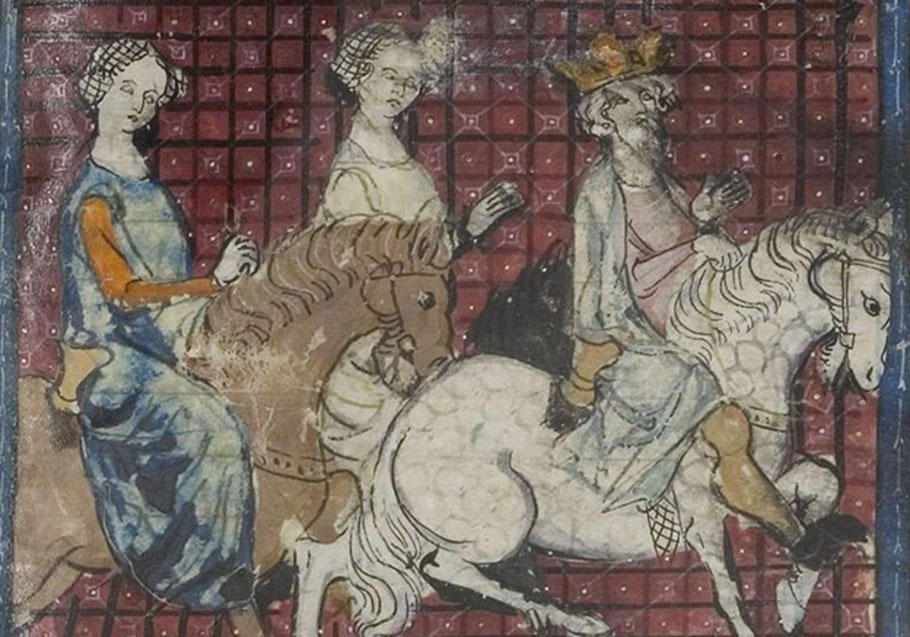
The Violent Life of Fredegund: Was She a Queen, a Murderess or a Woman Intent on Survival?
Fredegund (545 - 597 CE), the queen consort of Chilperic I - the Merovingian Frankish king of Soissons, has a reputation of being one of the most bloodthirsty and sadistic women in history. Accounts by Gregory, the Bishop of Tours (539 - 594 CE), depict her as a murderous woman who gained power by means of her husband and applied it to keep his kingdom in a state of war for more than forty years. She was also known as an early exponent of dirty warfare who relied heavily on poison and other covert operations.

Chilperic I (543-97) and Fredegund on Horseback, from the Grandes Chroniques de France, 1375-79 Bibliotheque Municipale, Castres, France. (Public Domain)
However, this same lady also survived political intrigues and retained her husband's loyalty despite the fact that, for a long time, she was unable to provide him healthy sons. Fredegund also developed innovative methods of assassination and was evidently compelling enough to persuade even monks and priests to join her causes. She was honored by her husband, accumulated great fortunes, put her son on the throne, and died a natural death. After her death, her son later honored her by punishing her enemies.
How a Servant Married a King: The Early Life of Fredegund
Fredegund was a servant woman of Chilperic's first wife Audovera. After Fredegund won Chilperic's affection, she persuaded him to put Audovera in a convent and divorce her although Audovera had borne him three sons. To put this feat in context it is worth remembering what kind of woman Fredegund would have been up against. Fredegund would have been little more than a concubine at the time, while Audovera was a Merovingian queen who traditionally was able to acquire political authority independent of that exercised by the king. The queen could issue donations and privileges, receive officials, as well as influence elections and draw upon the treasury to build a network of political loyalties. Audovera would have had plenty of time and resources to organize allies who could have opposed her political eclipse by a young concubine. Nevertheless, Audovera was eclipsed and virtually dropped out of the dynasty's history once Fredegund became the center of the court.

Chilperic strangling Galswinth Gallica Digital Library (Public Domain)
However, Fredegund still had to wait to marry her king. In 567, Chilperic married Galswinth, the older sister of Brunhild, queen of Metz through her own marriage to Chilperic's brother, King Sigebert. Gregory of Tour’s account says that the marriage was a happy one due to Galswinth’s large dowry. Further, as Galswinth and Brunhild were from the royal family of Visigoth Spain, a second marriage to a second Frankish king would have been a meticulously negotiated diplomatic event, which would have greatly influenced Europe. Fredegund would still have been a concubine at the time of Chilperic’s second marriage, or temporarily repudiated, until shortly after the wedding when Chilperic found Galswinth dead - strangled in bed. Within days, according to Gregory, Fredegund was back in the king’s bed.
To expand his territories, Chilperic later waged war on his brother Sigebert in 573. Unfortunately, Chilperic and was losing badly. Just as Sigebert’s army was raising him triumphantly on their shields, Fredegund had her agents hack Sigebert and his chamberlains to death with poisoned axes.
- Putting the Sex Back in Wessex: The Scandalous Reign of Queen Elgiva & Her Clash with a Demon-Fighting Bishop
- Tomoe Gozen - A fearsome Japanese Female Warrior of the 12th Century
- Researchers Unlock the Mystery of the Mummified Lung of a Merovingian Queen





